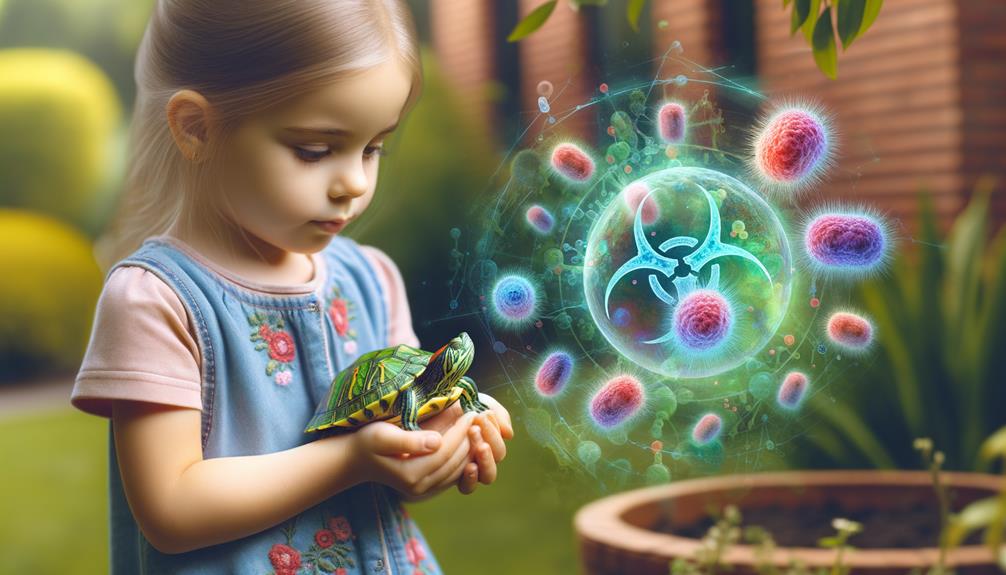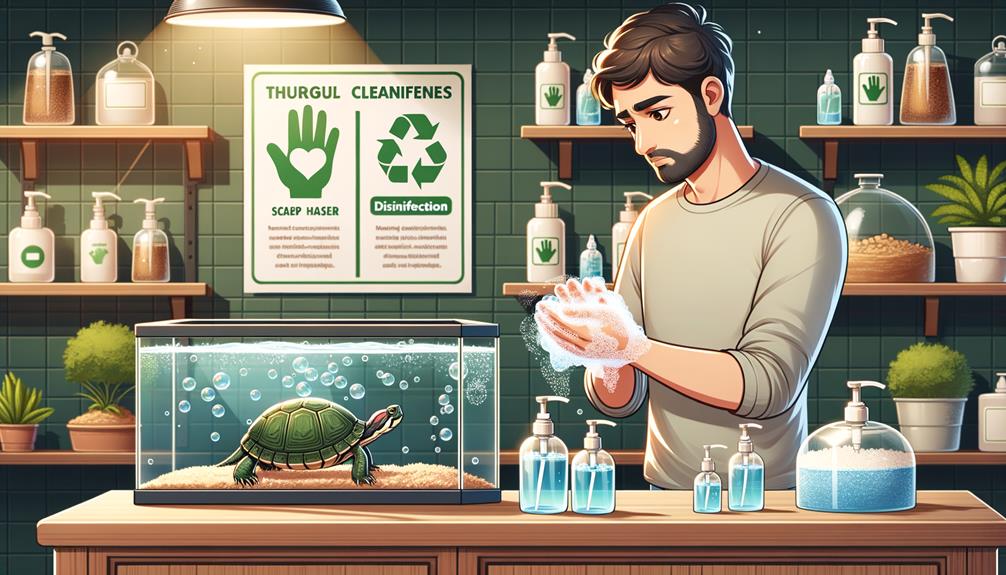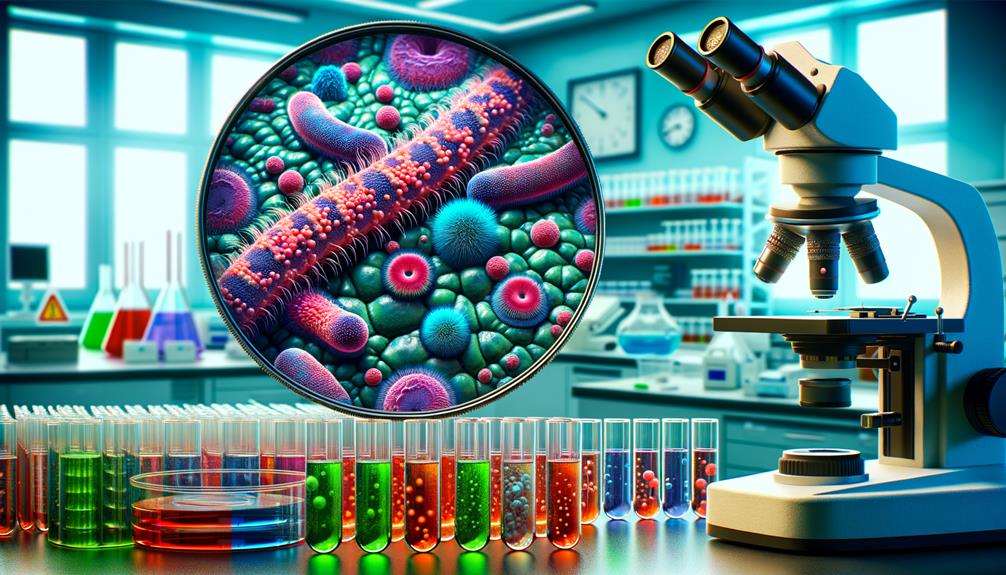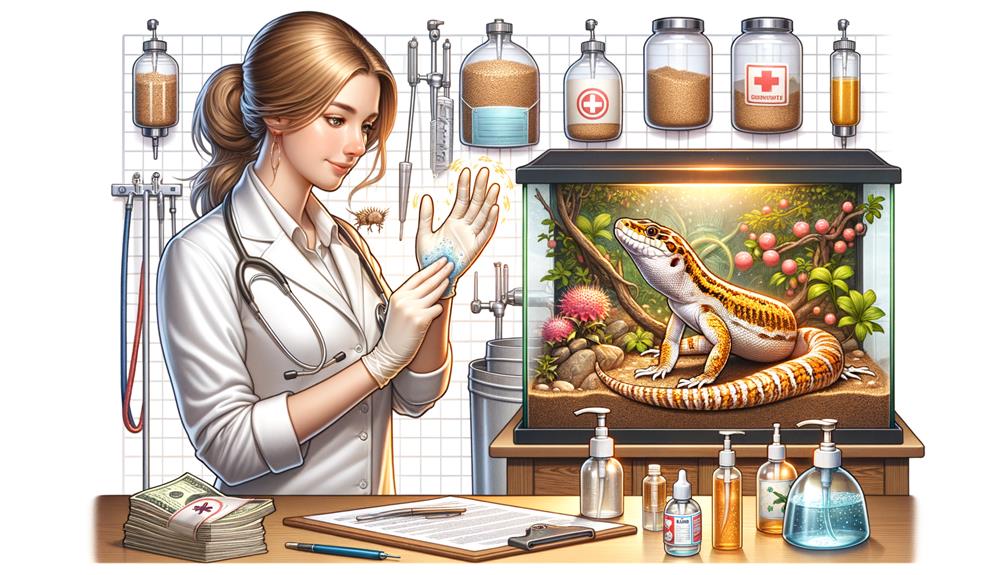Clarifying the Risks of Salmonella in Reptiles
Reptiles can carry Salmonella bacteria without showing any symptoms, making them a significant source of transmission to humans. Infections can be severe, especially among children, the elderly, and people with weakened immune systems. Pet shop reptiles have been found to have higher rates of Salmonella, and the bacterial strains can be similar to those that infect humans. To reduce the risk of transmission, it's crucial to practice good hygiene, such as washing your hands thoroughly after handling reptiles and cleaning their habitats outside. Reptile-associated Salmonella can be resistant to multiple antibiotics, making treatment more complicated. By taking proper care and maintaining vigilant hygiene practices, you can mitigate these risks.
Let's dive deeper into managing and preventing Salmonella transmission from reptiles.
Key Takeaways
Reptiles can carry Salmonella bacteria without showing any symptoms, posing a significant health risk to people, especially children, the elderly, and those with weakened immune systems.
When handling reptiles and their environments, it's crucial to practice good hand hygiene to prevent the transmission of Salmonella. Pet reptiles from stores often have a higher rate of Salmonella contamination, including multidrug-resistant strains.
To minimize the risk of contamination, use separate food containers for your reptiles and clean their supplies outside your home. If you have vulnerable individuals living with you, consider alternative pets to reduce the risk of Salmonella exposure.
Understanding Salmonella in Reptiles
Understanding Salmonella in reptiles starts with the fact that these cold-blooded creatures can carry the bacteria without showing any symptoms. Both pet reptiles and those in the wild have a high prevalence of Salmonella in their gut microbiome, which poses a significant health risk. This can lead to human salmonellosis cases, particularly in children who are more vulnerable to disease outbreaks.
The detection methods for Salmonella in reptiles have improved, but identifying asymptomatic carriers remains a challenge. When it comes to pet reptiles, it's crucial to handle them carefully and maintain good hygiene. Since the bacteria can be present without any visible signs of illness, it's difficult to determine the health risk just by observing the reptiles.
Looking at the data on human salmonellosis cases, it's clear that children are often the most affected due to their close interaction with pet reptiles. Therefore, understanding the prevalence of Salmonella in reptiles and improving detection methods are vital steps toward reducing these health risks. It's about finding a balance between the freedom of owning these fascinating creatures and the responsibility of managing potential dangers.
Transmission Risks to Humans

Reptiles pose a significant risk of transmitting diseases to humans, particularly through direct contact or contaminated environments, making good hygiene practices crucial for preventing salmonellosis. Snakes and lizards are the primary carriers of Salmonella, and handling these animals or their surroundings increases the risk of disease transmission, especially for vulnerable groups like young children, the elderly, and people with weakened immune systems. These groups face a higher health risk, as they can develop severe infections if exposed.
Reptiles from pet shops have a higher prevalence of Salmonella compared to those from private owners, highlighting the need for rigorous hygiene management in different settings. It's not just direct contact with the reptile that's risky, but also their food, waste, and habitats. Every instance of contact with contaminated surfaces or materials can facilitate the transmission of Salmonella to humans.
The genetic similarity between Salmonella strains in reptiles and associated human cases underscores the zoonotic potential of this disease. Understanding these transmission risks is vital for anyone involved in handling or owning reptiles. By being aware of these risks, we can better protect our health and that of our loved ones.
Prevention and Hygiene Practices

To prevent the transmission of Salmonella, it's crucial to practice good hand hygiene after handling reptiles or their environments. Wash your hands thoroughly with soap and water to minimize the risk of infection. Salmonella can be transferred to humans through contact with reptiles, their enclosures, or their food.
Dedicate separate containers for storing and thawing reptile food, like frozen feeder rodents, to prevent cross-contamination. Keep reptiles out of food preparation areas to avoid contamination. Supervise them when they're outside their habitat to minimize environmental contamination.
When possible, it's best to clean reptile supplies and habitats outside the home to reduce the spread of Salmonella and other pathogens within living spaces.
Households with young children, elderly, or immunocompromised individuals may want to consider alternative pets due to the higher risk of Salmonella infection associated with reptiles. These groups are more vulnerable to severe outcomes from infection.
Managing Multidrug-Resistant Strains

Managing multidrug-resistant strains of Salmonella in reptiles requires a comprehensive approach to ensure both animal and human health. It's crucial to understand that all isolated strains are resistant to at least one antibiotic. Enrichment procedures are vital for identifying and managing these strains effectively.
Reptile species, such as lizards, chelonians, and snakes, show similar resistance rates, indicating that targeted strategies should be applied universally. The reptile gut microbiome plays a significant role in the likelihood of shedding Salmonella. Even healthy reptiles can still carry and transmit these bacteria, making regular monitoring necessary.
Pet shops, where the prevalence of multidrug-resistant strains is high at 67%, need to implement stringent hygiene practices to minimize the risk of stress-induced shedding. In contrast, private owners' reptiles have a lower prevalence of 33%, highlighting the importance of controlled environments.
Careful handling and hygiene practices are essential to prevent the spread of Salmonella from reptiles to humans. Food products of animal origin must be handled and stored properly to avoid infections that can lead to multidrug-resistant strains. By making small changes in handling and hygiene practices, the risk of transmission can be significantly reduced, ensuring a safer coexistence with reptiles.
Best Practices for Reptile Care

Effective reptile care requires understanding their unique needs and implementing practices that minimize health risks. With the Salmonella detection rate being a significant concern, knowing the prevalence of Salmonella in different types of reptiles is crucial.
I closely monitor my reptiles for signs of disease, ensuring they remain healthy. However, the risk of spreading Salmonella to humans persists, especially through contact with turtles and other reptiles. Proper hygiene practices are vital, including thorough hand washing after handling reptiles or cleaning their habitats.
The shedding and risk factors vary among reptile species. For instance:
- Turtles have a high Salmonella prevalence, mainly due to frequent contact and water tanks.
- Snakes have a moderate Salmonella prevalence, often linked to poor habitat sanitation.
- Lizards have a variable Salmonella prevalence, which can be attributed to mixed diets and shared habitats.
Staying informed and vigilant is key to responsible reptile ownership. By understanding these nuances in reptile care, I can enjoy having healthy reptiles while minimizing the risk of spreading Salmonella. Maintaining a clean environment and recognizing early signs of disease are essential steps in keeping reptiles healthy.
Frequently Asked Questions
How Likely Are You to Get Salmonella From Reptiles?
How likely am I to get Salmonella from reptiles? It really depends on the species and their living environment. Snakes are the biggest risk, but with good hygiene practices, like washing my hands after handling them, I can significantly lower my chances.
How Can You Protect Yourself From Catching Salmonella From a Reptile?
Protecting yourself from catching Salmonella from a reptile requires some simple precautions. Firstly, wash your hands thoroughly after handling your pet or its enclosure. If you're in a high-risk group, such as the elderly, young children, or people with weakened immune systems, it's best to avoid contact with reptiles altogether. Keep your reptile's enclosure clean and well-maintained, and ensure it's kept away from food preparation areas. Regular veterinary check-ups are also crucial to ensure your pet's health and reduce the risk of Salmonella transmission.
How Likely Is It to Get Salmonella From a Bearded Dragon?
The risk of getting Salmonella from a bearded dragon is significant, considering their shedding rates. However, by following rigorous hygiene practices and handling them with caution, you can greatly reduce this risk.
How Long Does Salmonella Last on Surfaces?
Salmonella can survive on surfaces for a surprisingly long time – up to 4 hours on dry surfaces and as long as 4 days on moist ones. To minimize the risk, I make sure to clean and disinfect thoroughly, knowing that heat and disinfectants can effectively eliminate the bacteria.



